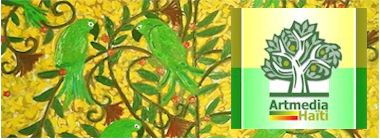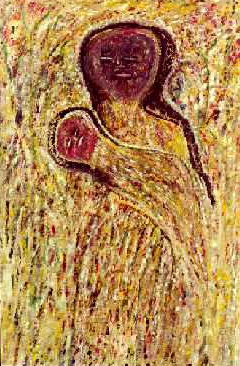
|
|
|
| � | |

|
Artists |
|
-�All Artists -�Early & Historical Masters -�Contemporary Masters -�Contemporary Moderns -�Contemporary Primitives -�Decorative Artists -�Private Collections |
|

|
Themes & Subjects |
|
-�Daily Life -�People & Portraits -�Nature -�Landscapes -�Religion & Mythology -�Danse & Music -�History |
|

|
Genres & Schools |
|
-�Abstract -�Artistes du Centre d�Art -�L�Ecole de l'Artibonite -�L�Ecole du Cap-Haitien -�L�Ecole de la Beaut� -�Saint Soleil |
|

|
Medium & Materials |
|
-�Oils -�Acrylics -�Watercolors -�Drawings -�Photography -�Scuplture -�Handicrafts |
|

|
Documents |
|
-�Biographies & Profiles -�Articles & Commentary -�Testimonials & Tributes -�Books & Essays -�Videos & Films -�Tapes & Cds -�The AMH Online Journal -�The Visitor�s Canvas -�Resources -�Haiti Links -�Art Links |
|
| � |
| --> Category: History Of Haitian Art - HaitianPainting.com� |
| � |

|
| � |
| Today Haiti is well represented by self-taught and trained artists and the visual arts are flourishing like nowhere else in the Caribbean. |
| � |
|
The History Of Haitian Art DeWitt Clinton Peters, a name highly referred to in the art community for the widespread recognition of Haitian Art went to Haiti to teach high school English as an alternative to military service during World War II in 1943. Peters, a talented watercolorist from California with a passion for painting was surprised to find no art gallery or any place where one could exhibit paintings. He had a dream of opening an institution that would convince talented Haitians that art was not only a respectable occupation but also a better way of making a living than sweeping a yard or driving a taxi. Le Center d'Art, a building donated to Peters by the Haitian government and still in existence today was opened in 1944 by Peters after he resigned from his teaching position. He intended the center to serve as a combination art school and art gallery; where Haitians could receive academic instruction in both drawing and oil techniques. Surprisingly, the founders of the Art Center discovered a wealth of talent that would affect the history of the art movement in Haiti. In search of local art, Hector Hyppolite, mysterious Voodoo priest, who painted using chicken feathers and leftover house paint, was one of the first painters to be discovered by Peters. Realizing the potential in local primitive art, he started to seek out other local talents. Artists from the most varied and unlikely backgrounds started to emerge. Philom� Obin; a clerk, Peter's house boy, Castera Bazile; a taxi driver, Rigaud Benoit; the Art Center's yard boy, Sisson Blanchard; a bookkeeper, Toussaint Auguste; Petion Savain, Wilson Bigaud, Robert Saint-Brice; a factory worker named Jasmin Joseph, and others. These men known as the first generation of artist were self-taught, and were hungry and motivated enough to pursue the dream of becoming an artist. Their paintings were full of passion and imagination. They were able to translate their environment, religious observances on canvas and cardboard. Selden Rodman, became co-director of the Centre in 1947, convinced Peters that the artists were ready to move from the small pictures to immovable walls of public buildings. Rodman then organized and supervised the work on the murals of the Holy Trinity Episcopal Cathedral in Port-au-Prince. Finished in 1951, these murals attracted world attention and also launched a number of primitive artists who soon became internationally known, with collectors from all over the world seeking their work. What may have appeared anecdotal in the beginning had over time crystallized into two major themes for these artists without training, they basically told the history of Haiti and their daily lives. Today Haiti is well represented by self-taught and trained artists and the visual arts are flourishing like nowhere else in the Caribbean. The founding of the Centre d'Art in 1944 with DeWitt Peters and its directors has played a major role in the Haitian Renaissance. The History of Haitian Art by HaitianPainting.com 89 Summit Ave #266 Summit, NJ 07901, USA Telephone: 800-685-4138, 908-352-5152 Fax:908-436-2676 HaitianPainting.Com http://www.haitianpainting.com [email protected] |
| � |
|
|
||
 Designed and Maintained by InterMedia, The Internet Communications Network of Haiti�  ArtMediaHa�ti Suite 200 - Angles des Rues Gr�goire et Chavannes P.O. Box 16042 - P�tionville, Haiti Telephone: (509) 511-1314, 557-5290, 403-1130, 401-1626 - Fax: (626) 608-3594 http://www.artmediahaiti.com [email protected] |
||
| Service | Contact | Cart-Panier | Home-Accueil | ||
| � | ||
| � All Rights Reserved-Copyright�2001-2002 by ArtMedia Haiti-Port-au-Prince, Haiti | ||